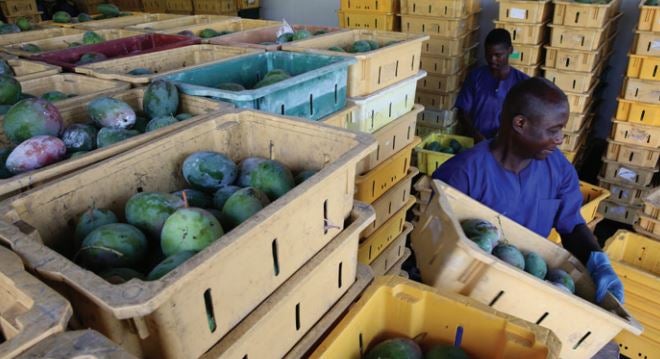Also available in: French | Spanish | Chinese | Arabic

Technology and the internet are probably the first things that come to mind when you think about the future of work for young people; not agriculture or farming. This makes historic sense, as agriculture sheds labor when countries develop. And the traditional ways of producing food do not look particularly sexy. Yet, technology and the internet are also opening up opportunities for agriculture, and urbanization and changing diets are calling for new ways to process, market and consume our foods. So, can agriculture provide job opportunities for youth?
Fewer but better jobs in farming
First, undoubtedly, the share of farming jobs is shrinking. This is normal. As countries urbanize and incomes rise, food expenditures decline as a share of total spending. To help produce these other goods and services, farmers take up jobs off the farm. Yet the process can only be sustained if labor productivity in farming increases, through innovation in production as well as better access to markets to sell the surplus. ICT is helping with both.Take automation. The lack of mechanization in Africa has long puzzled many observers, who, given the region’s current population density and market access, had long expected to see much more mechanization on the continent. Yet, there are now signs that it may be starting to happen, through machinery services, facilitated by ICT.
The current leading example is “ Hello Tractor”, an innovative platform in Nigeria to co-share tractors using SMS, GPS, and smart sensors. This “ Uber for tractors ” has enabled access to smart tractors at the doorstep of small farmers resulting in a significant increase in productivity through mechanization. Nonetheless, many challenges remain for mechanization across the region, including access to finance, in the timely availability of support services and in attaining scale. Temptations to subsidize mechanization should be resisted, ensuring that the process remains compatible with market forces instead, as revealed through factor price ratios (labor over capital and labor over land).
The potential benefits from ICT in increasing agricultural labor productivity are not limited to mechanization. ICT also helps improve agronomic practices by facilitating extension, and importantly, it increases farmers’ access to markets (old and new), and can leverage their bargaining position, enabling them to get a better price for their produce. Farmbook in Africa and MFarming in Tanzania are just some of the more recent initiatives using ICT tools to do so. Better market access and higher prices will in turn foster the adoption of productivity enhancing technologies to increase supplies. This opens up important perspectives for rural youth to raise their income in agriculture.
Some opportunities are further emerging within the urban areas themselves. Between 1,000 and 15,000 farming jobs, have for example been created in urban centers like Bamako, Accra, and Kumasi, and even megacities such as Shanghai maintain their urban farming as an important part of the economic system.
The technologies are at times often also quite advanced, such as those applied by Fresh Direct Nigeria –recent winner of the WEF African Technology Entrepreneur of the Year award- who has pioneered peri-urban fresh food production through stackable container farms. By using hydroponics, its organic urban farms use less water and land than conventional farming while producing 15 times higher yield, and enabling urban population access high quality produce.
Agriculture dependent jobs
To better prepare youth and women to take up these jobs, the Africa Agribusiness Incubators Network ( AAIN) is establishing at least 108 incubators in 54 African countries in the next five years focusing on youth and women. The AAIN’s plan is to expose 60,000 students to the “learn as you earn model” and mentor them to start new businesses. This way they aim to create at least 600,000 jobs and 100,000 start ups and SMEs.
The future of jobs in agriculture
Follow the World Bank Jobs Group on Twitter @wbg_jobs.


Join the Conversation